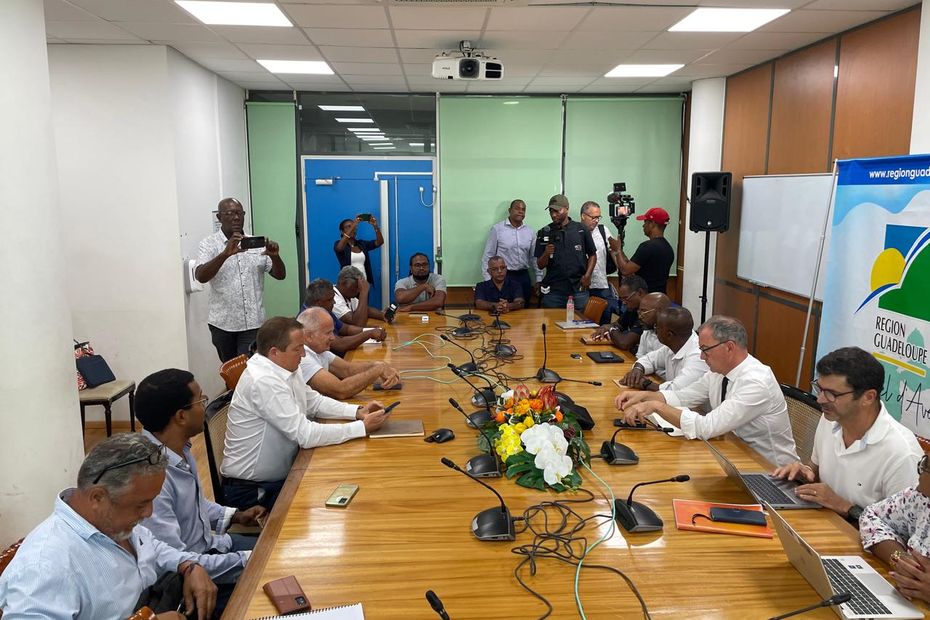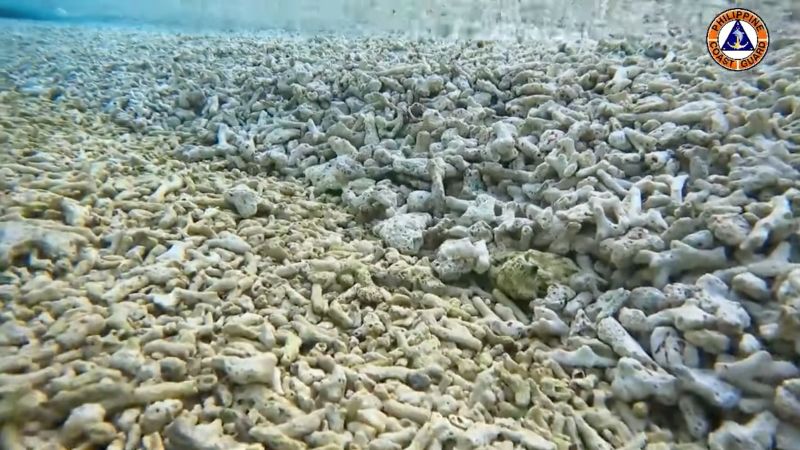CNN
—
A vibrant coral reef filled with colorful fish and seaweed just two years ago has turned into a wasteland of crushed coral in the South China Sea, and the Philippines says it has identified the culprit — China’s shadowy maritime militia.
China has rejected the accusation, leading to another public row with its neighbor over the troubled waterway.
Videos released by the Philippine Coast Guard on Monday showed a wide swath of bleached coral along Rosol Reef (Iroquois) and Sabina Reef (Escoda) in the South China Sea, underwater features within the country’s internationally recognized exclusive economic zone.
Both reefs are located near Palawan, a chain of islands southwest of the Philippines overlooking the South China Sea, but Beijing claims most of the large and strategic waterway as its own territory despite competing claims by neighbors and in defiance of an international ruling.
Commodore Jay Tarella, a Coast Guard spokesman, said divers conducted “underwater surveys” of the seafloor and described “obvious discoloration” that indicated “deliberate activities” aimed at modifying the terrain’s natural topography.
“The continued swarm of indiscriminate, illegal and destructive fishing activities carried out by the Chinese maritime militia at Rosol Reef and Escoda Shoal may have directly caused the degradation and destruction of the marine environment in [West Philippine Sea] “Features,” Tarella said in a statement, referring to the name Manila gives to parts of the South China Sea under its jurisdiction.
Philippine Coast Guard/Facebook
Fragments of bleached coral have accumulated around Rosol (Iroquois) Reef, according to the Philippine Coast Guard.
Between Aug. 9 and Sept. 11, the Coast Guard monitored 33 Chinese vessels near Rosol Reef and about 15 Chinese vessels near Escoda Shoal, Tarella said.
“The presence of crushed coral strongly suggests that a dumping operation may have occurred, possibly involving the same dead coral that had previously been treated and cleaned before being returned to the seafloor,” Tarella added.
Last Saturday, the Philippine Army also accused Chinese maritime militias of causing massive destruction in the region.
Chinese authorities had not commented publicly on the accusations until Thursday when the Foreign Ministry was asked at a regular daily news conference about the destruction of the coral reefs.
“The relevant allegations of the Philippine side are false and baseless,” spokesman Mao Ning told reporters. “We advise the Philippine authorities not to use fabricated information to create a political farce.”
Beijing claims “indisputable sovereignty” over nearly all of the South China Sea’s 1.3 million square miles, as well as most of the islands and sandbars within it, including many landmarks hundreds of miles from mainland China. This includes the Spratly Islands, an archipelago of 100 small islands and reefs that is fully or partially claimed by the Philippines, Malaysia, Brunei and Taiwan.
Over the past two decades, China has occupied a number of reefs and atolls across the South China Sea. Construction of military facilitiesIncluding runways and ports, which has not only challenged the Philippines’ sovereignty and fishing rights, but also endangered marine biodiversity in the highly contested resource-rich waterway.
Some atolls and islands were built on a saw Conduct sustainable land reclamation, Often coral reefs are destroyed first and then built upon.
DigitalGlobe/ScapeWare3D/Maxar/Getty Images
China regained land in the Fiery Cross Reef area in the western part of the Spratly Islands group, and built a runway that was completed in 2018.
In 2016, an international tribunal in The Hague ruled in favor of the Philippines in a historic maritime dispute, concluding that China had no legal basis to claim historic rights over much of the South China Sea.
But Beijing has ignored the decision and continues to expand its presence in the waterway.
Recent Philippine Coast Guard footage of broken and bleached corals is in stark contrast to what happened just two years ago.
The University of the Philippines Marine Sciences Institute said in a statement to CNN that it surveyed part of the Rozul (Iroquios) Reef in 2021 through an expedition funded by the country’s National Security Council aboard the ship M/Y Panata.
Videos and photos taken by the institute in 2021 showed the Roswell (Erogeus) Reef filled with red and purple corals with aquatic algae and algae lining the reef.
“At that time, we found that the surveyed area had a coral reef ecosystem, with corals, benthic animals, fish, seaweeds and other marine organisms,” she said, but stopped short of commenting on the current status of the reef since the last report. The information received from the Philippine Army and Coast Guard was “beyond the scope” of the institute.
“However, we are open to working with other agencies to validate and analyze the impacts of recent activities in the area. Such situations underscore the need for continuous monitoring and support for more marine scientific research activities by Filipino scientists especially in the West Philippine Sea,” she added.
UP Institute of Marine Sciences
The UP Institute of Marine Science discovered a vibrant coral reef at the Rozul (Iroquios) Reef in the South China Sea in May 2021.
Signs of marine degradation have highlighted threats to coral harvest in the area, prompting several Philippine senators to raise doubts about whether China has plans to militarize the atolls through reclamation, CNN affiliate CNN reported. CNN Philippines mentioned.
“It’s a wake-up call,” said Jerry Arancis, executive director of the Center for Energy, Environment and Development (CEED).
Arancis said the images revealed the maritime effects of China’s construction of island facilities in the waters, frequent militia ship patrols and expanded commercial fishing.
“It shows a lot of weaknesses, in terms of monitoring, regulation and overall protection of marine biodiversity,” he said.
Western maritime security experts, along with officials from the Philippines and the United States, have increasingly accused Beijing of using civilian fishing vessels ostensibly as a maritime militia that serves as both an unofficial — and officially deniable — force used by China to push its territorial claims. In and beyond the South China Sea.
They are called the “Little Blue Men” in BeijingChinese fishing vessels have also been involved in clashes with fishing vessels from Indonesia and Vietnam in disputed waters.
Last month, the Philippines A Clashes between the Chinese Coast Guard and Philippine ships It included at least two blue-hulled ships that resembled fishing vessels.
“There has been a collective failure internationally to respond to China’s actions in the South China Sea, with respect to the militarization of reefs and shoals in which China has, over a period of time, seized pristine maritime features and turned them into tangible military bases,” said Ray Powell, director of SeaLight. At Stanford University’s Gordian Knot Center for National Security Innovation: “The collective response of many environmental advocacy groups has been muted.”
Powell added that the Philippines’ increasing calls for transparency on China’s maneuvers in disputed waters have enabled the country to garner international support from its allies to assert its territorial sovereignty.
At least two foreign ambassadors in Manila have expressed concern over reports of the destruction of marine resources in the South China Sea.
U.S. Ambassador to the Philippines Mary Kay Carlson described reports of coral destruction around the reef as “worrying“, according to a post on X, formerly known as Twitter.
“Habitat damage harms ecosystems and negatively impacts lives and livelihoods. We are working with #FriendsPartnersAllies to protect [the Philippines’] “Natural resources,” she said Monday.
Japanese Ambassador Kazuhiko Koshikawa also described the development as “Very disturbing newsHe also urged everyone to protect “these vital ecosystems.”
The Philippine Foreign Ministry said in a statement that the country “has been raising the alarm.” Environmentally harmful activities carried out by foreign ships in their maritime areas.
Former President Rodrigo Duterte tried to forge closer ties with Beijing and made plans to cooperate on oil and gas exploration in the South China Sea, a move that divided Filipinos over the legitimacy of enabling China’s ambitions in the disputed region.
Ted Algibi/AFP/Getty Images
The Philippine Navy ship Sierra Madre, used by Manila to support its territorial claims at Second Thomas Shoal in the disputed Spratly Islands in the South China Sea, is pictured on April 23, 2023.
According to the Asian Maritime Transparency Initiative, the Philippines occupies nine areas in the Spratly chain while China occupies seven. But Beijing, which calls the island chain the Nansha Islands, has built up and fortified many of its claims in the chain, including building military bases at places like Subi Reef, Johnson Reef, Mischief Reef and Fiery Cross Reef.
By contrast, only one of the landmarks controlled by the Philippines has an amphitheater, Thito Reef.
In 1999, the Philippines deliberately grounded a naval transport ship, BRP Sierra Madre, on board the Second Thomas Shoal, operated by the Philippine Marines, to enforce the country’s claim to the area.
At Thursday’s press conference, a Chinese Foreign Ministry spokesman also referred to the Sierra Madre.
“If the Philippine side is really concerned about the ecological environment of the South China Sea, it should withdraw the warships illegally stationed on the Renai Reef as soon as possible and stop discharging sewage into the sea, as well as to prevent irreparable damage.” “The warships rusted in the sea,” she said, using the Chinese name for coral reefs.
Powell said that under current President Ferdinand Marcos Jr., the country’s national security team has begun publishing its findings on what is actually happening in the West Philippine Sea and South China Sea more regularly.
“The Philippine government’s policy of transparency has earned it a lot of domestic support for its resistance and international support for its position,” he said.

“Infuriatingly humble alcohol fanatic. Unapologetic beer practitioner. Analyst.”








More Stories
Israel's war on Gaza live: Israel bombs Gaza as student protests grow | News of the Israeli war on Gaza
Hamza Yousaf will not resign from the position of First Minister of Scotland
Talks between the United States and China begin with warnings about misunderstanding and miscalculation